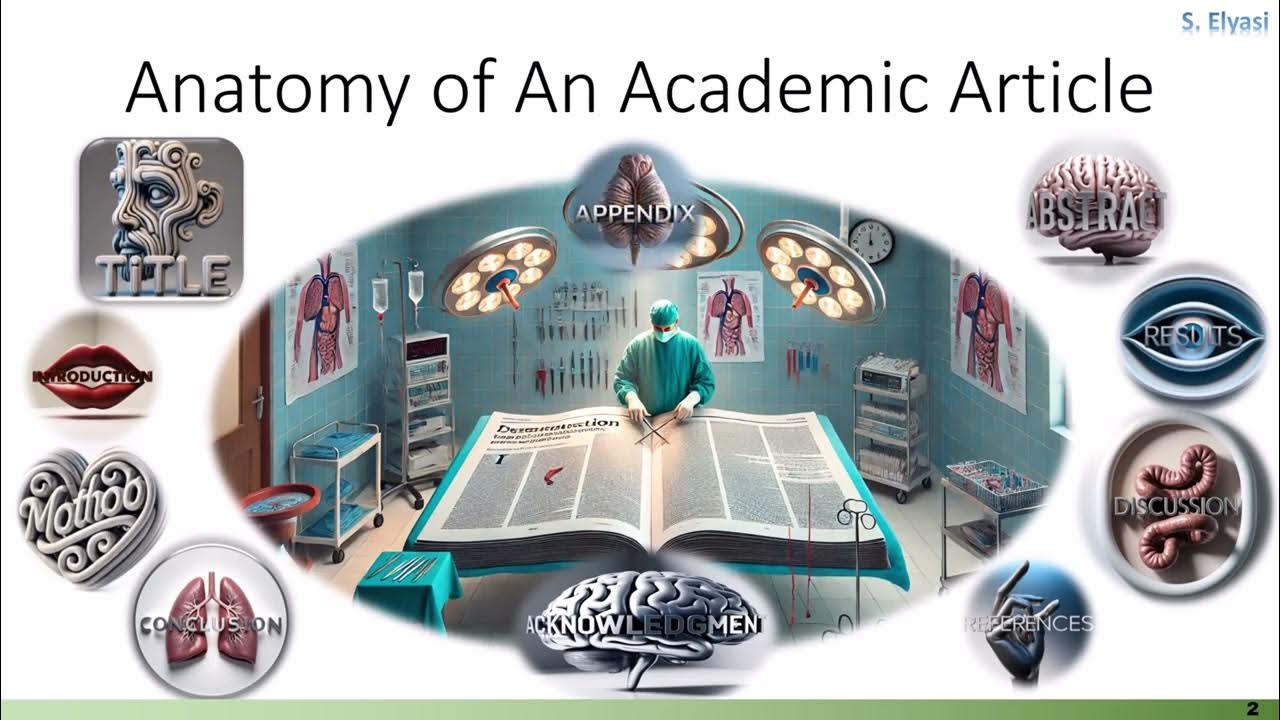The Anatomy of a Scientific Article
Summary
TLDRThis script outlines the structure of scientific articles, emphasizing the importance of each section. It begins with the title and author details, followed by the abstract, a condensed summary. The introduction sets the context, while the methods section details the study's design. The results present findings, and the discussion interprets them, often highlighting the study's limitations. The conclusion summarizes the study's significance and suggests further research. Lastly, the references section lists all cited literature, providing a foundation for future work.
Takeaways
- 📄 All scientific articles start with a title that accurately reflects the content and findings.
- 👤 Author information, including names and affiliations, is typically found above or below the title.
- 🔍 The abstract provides a concise summary to help readers quickly assess the article's relevance.
- 📚 Abstracts may be structured with bolded headings or presented as simple paragraphs.
- 📝 The introduction orients readers to the study's focus and context, justifying the research.
- 🔬 The methods section details how the study was conducted, allowing for replication by other researchers.
- 📊 The results section presents findings without analysis, focusing solely on the facts.
- 💬 The discussion interprets the results, arguing their significance and implications.
- ⚖️ Authors may reference previous studies to demonstrate consensus or highlight study limitations.
- 📑 The conclusion summarizes the study's relevance and often calls for further research.
Q & A
What is the primary purpose of a scientific article's title?
-The primary purpose of a scientific article's title is to provide an accurate and concise description of the article's content and findings.
Where can one find the author information in a scientific article?
-Author information, including names, professional qualifications, institutional affiliations, and sometimes contact information, can be found above or beneath the title of a scientific article.
What is the role of an abstract in a scientific article?
-An abstract serves as a concise, formal summary designed to help readers quickly determine whether the entire article is relevant to their research interests.
What are the typical contents of an abstract in a scientific article?
-An abstract generally contains one to three sentences corresponding to each of the article's sections or subsections, and it often mirrors the organization of the rest of the article.
What is the function of the introduction section in a scientific article?
-The introduction orients readers to the focus and context of the present study, explaining why the research was conducted and what problem it aimed to address.
Why is the methods section crucial in a scientific article?
-The methods section is crucial because it explains how the study was conducted in enough detail that another researcher could replicate the study exactly.
How does the results section differ from the discussion section in a scientific article?
-The results section presents notable and relevant study findings without any analytical explanation, while the discussion contains the author's analytical interpretation of the results.
What should readers expect to find in the discussion section of a scientific article?
-In the discussion section, readers should expect to find the author's interpretation of the results, the significance, and implications of those results, and sometimes the study's strengths and weaknesses.
What is the conclusion section of a scientific article typically responsible for?
-The conclusion section presents a concise summary of the study's relevance and often includes a call for more research.
Why is the references section important in a scientific article?
-The references section is important not only for giving credit where it's due but also as a resource for writers and researchers who need to consult a wide array of literature.
Outlines

This section is available to paid users only. Please upgrade to access this part.
Upgrade NowMindmap

This section is available to paid users only. Please upgrade to access this part.
Upgrade NowKeywords

This section is available to paid users only. Please upgrade to access this part.
Upgrade NowHighlights

This section is available to paid users only. Please upgrade to access this part.
Upgrade NowTranscripts

This section is available to paid users only. Please upgrade to access this part.
Upgrade Now5.0 / 5 (0 votes)





